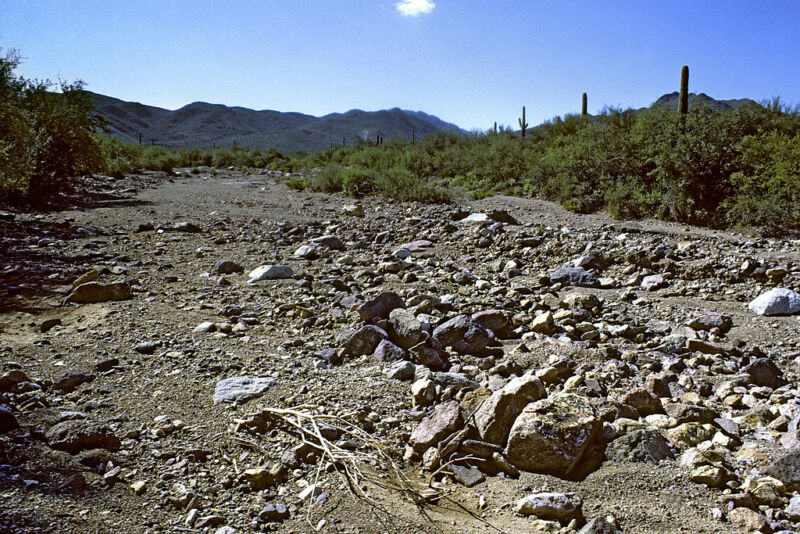In deep —
Current policy is arbitrary and capricious; new policy isn’t ready yet.
John Timmer
–

Enlarge / Even though this stream bed is dry much of the year, it still may qualify for regulation under the Clean Water Act.
The latest legal decision in a years-long fight over how to implement the Clean Water Act has set rules back to where they were in the 1980s. The reversion is the product of the Trump administration’s haste to get rid of Obama-era regulations, leading to action that produced rules running counter to the Environmental Protection Agency’s own scientific findings. As a result, a judge has decided that the rules cannot remain in place for the time that will be needed for the Biden administration to formulate replacements.
Defining water
The long-running saga is the product of the Clean Water Act’s remarkably vague protections. The act seeks to control pollution via a permitting process that applies to the “waters of the United States,” but it doesn’t define what constitutes said waters.
While the process would clearly apply to a flowing river, it’s less clear whether the act would regulate the pollution of a stream bed only filled seasonally or following heavy rains—even though the stream bed can flow directly into a river that is active year-round. Similar issues apply to items like man-made ponds that connect to other bodies via groundwater flow.
In the absence of a clear definition in the statute itself, the relevant agency—in this case, the EPA—has been left to define what is regulated via a federal rule-making process. During the Obama administration, the EPA recognized that the then-active rules, which dated from 1986, were unpopular with both businesses and environmentalists and were increasingly out of step with our scientific understanding of the role of groundwater and seasonal bodies of water. So the agency began the process of formulating new rules, which required proposing them, soliciting public feedback, and modifying the rules in response.
The rules, finalized near the end of Obama’s second term, covered a wider range of small bodies of water and wetlands. This outcome proved highly unpopular with business interests, which tied up the rules’ adoption in court long enough for President Trump to withdraw them in order to formulate his own.
On again, off again
Trump’s EPA ultimately produced the Navigable Waters Protection Rule, which went into effect near the end of Trump’s time in office. This rule largely reversed the changes made by the previous administration, removing permit requirements for things like man-made channels, groundwater, and stream beds that only fill following rains. The draft version of the Navigable Waters Protection Rule was specifically criticized by the EPA’s own science advisory board as ignoring our current scientific understanding and being incompatible with the aims of the Clean Water Act.
So it was no surprise that this rule also ended up in court, with one case involving Native American tribes in the Southwest, where many bodies of water are only active following rainfall. And once again, with the change in administration, the Biden EPA asked the court to suspend the case while it formulated a replacement for the Navigable Waters Protection Rule. In the meantime, however, the administration asked the court to allow the rule to remain in place to prevent things from reverting to the definition that dates back to the 1980s.
And that’s where the new decision from US District Judge Rosemary Márquez was needed. The Tribal plaintiffs asked that the judge accept the suspension of the case but vacate the Navigable Waters Protection Rule in the process, reverting things to the post-1986 status quo. They argued that leaving the rule in place risked irreparable harms to the watercourses in their area of the country.
How to decide?
Márquez determined there were several reasons that the Navigable Waters Protection Rule would have to go. For example, precedent indicated that “an agency conclusion that is in direct conflict with the conclusion of its own experts… is arbitrary and capricious,” and arbitrary and capricious rules violate the Administrative Procedure Act that governs federal rulemaking. And, as indicated by the EPA’s science advisory board, this rule was clearly in conflict with the opinions of the EPA’s own experts.
Accordingly, the rule could not be fixed by simply providing a better legal justification; Márquez said that the rule needed to be thrown out and rewritten, a process the Biden administration had already indicated it intends to engage in.
The decision about whether to retain the rule in the meantime is determined by whether its flaws would enable harm during the time in which it’s being replaced. And here, the plaintiffs made a strong case that harm would come. They noted that the federal government itself has identified over 300 projects that would have required permits under the Obama-era rules but not under the Trump version. In New Mexico and Arizona, where the Tribes are located, the vast majority of the 1,500 streams would not require permits under the Navigable Waters Protection Rule.
Overall, when it comes to revoking the rule, Márquez concluded that “the seriousness of the Agencies’ errors in enacting the Navigable Waters Protection Rule, the likelihood that the Agencies will alter the Navigable Waters Protection Rule’s definition of ‘waters of the United States,’ and the possibility of serious environmental harm if the Navigable Waters Protection Rule remains in place upon remand, all weigh in favor.”
Unless the case is appealed, that’s the end of the Navigable Waters Protection Rule. Over the course of the last five years, businesses have had to deal with three separate standards for determining whether permits are needed—with one of them being in force two different times. And within the next two years, a new rule will be formulated and put on hold while court cases are filed.

